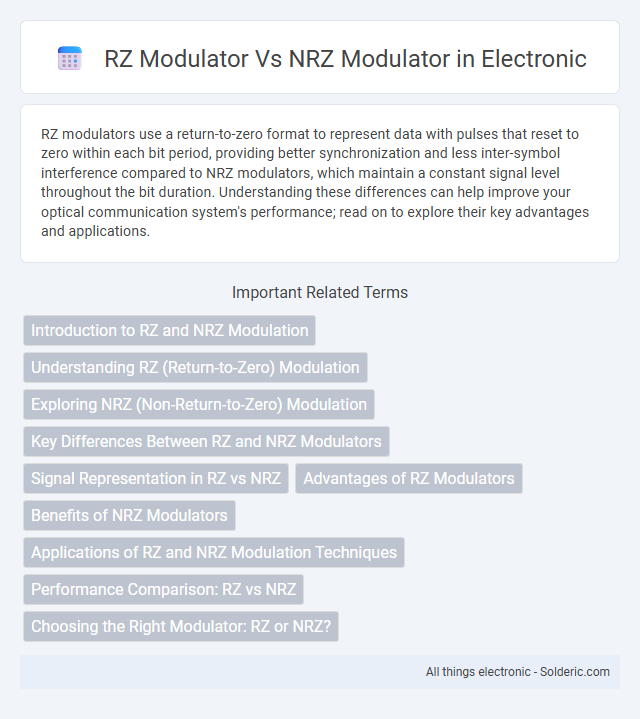RZ modulators use a return-to-zero format to represent data with pulses that reset to zero within each bit period, providing better synchronization and less inter-symbol interference compared to NRZ modulators, which maintain a constant signal level throughout the bit duration. Understanding these differences can help improve your optical communication system's performance; read on to explore their key advantages and applications.
Comparison Table
| Feature | RZ Modulator | NRZ Modulator |
|---|---|---|
| Signal Format | Return-to-Zero (pulse returns to zero between bits) | Non-Return-to-Zero (signal constant during bit duration) |
| Bandwidth Utilization | Higher bandwidth due to signal transitions | Lower bandwidth, more bandwidth-efficient |
| Timing Recovery | Easier due to clear zero crossings | Harder, requires additional techniques |
| Power Efficiency | Lower, as signal returns to zero energy frequently | Higher, constant signal level saves power |
| Error Rates | Lower Bit Error Rate (BER) in noisy channels | Higher BER compared to RZ under noise |
| Complexity | More complex modulator design | Simpler architecture |
Introduction to RZ and NRZ Modulation
RZ (Return-to-Zero) modulation represents data by switching the signal between high and zero within each bit period, enhancing timing synchronization at the cost of increased bandwidth. NRZ (Non-Return-to-Zero) modulation maintains a constant signal level throughout the bit duration, providing higher spectral efficiency with potential challenges in clock recovery. Both modulation schemes are fundamental in digital communication systems, influencing error rates and bandwidth utilization across optical and electrical transmission channels.
Understanding RZ (Return-to-Zero) Modulation
RZ (Return-to-Zero) modulation distinctively signals data bits by returning to zero voltage between each bit, providing better synchronization and reduced intersymbol interference compared to NRZ (Non-Return-to-Zero) modulation, which maintains a constant voltage level. This return to zero enables improved detection accuracy in high-speed optical communication systems by minimizing timing errors and channel distortion. Your choice between RZ and NRZ should consider factors such as bandwidth efficiency, noise tolerance, and system complexity.
Exploring NRZ (Non-Return-to-Zero) Modulation
NRZ (Non-Return-to-Zero) modulation maintains a constant signal level throughout the bit interval, offering higher spectral efficiency and simpler hardware implementation compared to RZ (Return-to-Zero) modulation, which returns to zero between bits. NRZ modulation reduces bandwidth requirements and enhances data transmission rates by minimizing signal transitions, making it preferred in high-speed digital communication systems. However, NRZ signals are more susceptible to baseline wander and synchronization issues, necessitating careful clock recovery techniques.
Key Differences Between RZ and NRZ Modulators
RZ (Return-to-Zero) modulators transmit signals by returning to zero voltage between each bit, enhancing synchronization but consuming more bandwidth compared to NRZ (Non-Return-to-Zero) modulators, which maintain a constant voltage level throughout the bit interval. Your choice between RZ and NRZ modulators impacts system performance; RZ provides better timing accuracy and reduced inter-symbol interference, while NRZ offers higher spectral efficiency and simpler circuitry. Understanding these key differences helps optimize data transmission quality and bandwidth utilization in communication systems.
Signal Representation in RZ vs NRZ
RZ modulator represents data by returning the signal to zero between each bit, resulting in a pulse for every '1' and a zero level for '0', which improves synchronization but consumes more bandwidth. NRZ modulator maintains a steady voltage level throughout the bit interval, representing '1' and '0' with distinct voltage levels without returning to zero, allowing higher spectral efficiency but risking synchronization difficulties over long sequences of identical bits. The distinct signal representation in RZ enhances timing recovery, while NRZ's constant-level signals favor bandwidth efficiency in digital communication systems.
Advantages of RZ Modulators
RZ modulators provide superior timing synchronization due to their distinct pulse intervals, reducing intersymbol interference compared to NRZ modulators. They offer improved signal integrity and higher tolerance to noise and dispersion in optical communication systems. This results in enhanced performance for high-speed data transmission over long distances.
Benefits of NRZ Modulators
NRZ modulators offer higher spectral efficiency and simpler implementation compared to RZ modulators, making them ideal for long-distance fiber optic communication systems. Your data transmission benefits from reduced bandwidth requirements and increased signal power efficiency. This leads to improved system performance with lower cost and complexity in optical networks.
Applications of RZ and NRZ Modulation Techniques
RZ (Return-to-Zero) modulation is widely used in high-speed optical communication systems due to its improved timing synchronization and reduced intersymbol interference, making it ideal for long-distance fiber optic links and high-bit-rate data transmission. NRZ (Non-Return-to-Zero) modulation is prevalent in digital communication protocols such as Ethernet and serial data interfaces, offering efficient bandwidth utilization and simpler implementation for short to medium-range transmission. Both RZ and NRZ modulation techniques are essential in designing communication systems optimized for different performance metrics like signal integrity, power consumption, and spectral efficiency.
Performance Comparison: RZ vs NRZ
RZ modulators offer better timing synchronization and lower bit error rates compared to NRZ modulators, enhancing signal integrity in high-speed optical communications. NRZ modulators provide higher spectral efficiency and require less bandwidth, making them suitable for long-distance transmissions with limited channel capacity. Your choice between RZ and NRZ modulators should consider the trade-off between improved performance in noisy environments and efficient use of bandwidth.
Choosing the Right Modulator: RZ or NRZ?
Choosing the right modulator between Return-to-Zero (RZ) and Non-Return-to-Zero (NRZ) depends on the communication system's requirements for bandwidth efficiency and signal integrity. RZ modulators offer better timing synchronization and reduced intersymbol interference, making them suitable for high-speed optical communication over shorter distances. NRZ modulators provide higher spectral efficiency and simpler circuitry, ideal for longer distances and systems where bandwidth conservation is critical.
RZ modulator vs NRZ modulator Infographic

 solderic.com
solderic.com